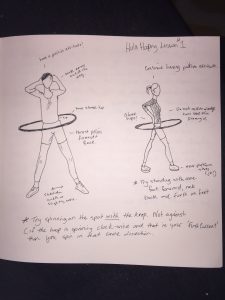Contemporary Hoop Dance, Lesson One.
Put the hula hoop around your waist. You can either spin it to the left or the right. One direction will feel more comfortable and natural than the other. Much like how some people are left handed and some people are right handed. It’s important to try both directions to see which feels more natural. We will refer to our dominant direction as ‘First Current’ and our non-dominant direction as ‘Second Current’
Stand with the hula hoop on your waist with your feet shoulder width apart. Give the hoop a toss and try thrusting your pelvis forward to get started. Some people prefer to stand with one foot in front of the other and rock back and forth on their feet. Both ways are good for beginners.
There are four main points of contact your hoop will contact your body. Front left just above the hip, back left just above the hip, back right just above the hip and front right just above the hip. This will, of course, be in reverse order depending on which direction is your First Current.
It is important to give this several tries. The ability to keep a hula hoop up and on your waist come with time. We refer to this term as ‘Airtime’. The more Airtime you put in, the better you will get and the more likely you are to succeed. The key is perseverance. Eventually after trial and error, your body begins to understand what your brain is asking it to do.
Once you’re able to keep the hoop on your waist for a few rotations you’ll notice that it will likely start to slide below your hips and to the floor. In order to avoid this, you can spin with your hoop. That is, try spinning in the same direction as the hoop as it spins around your body. This is slow down the hula hoops momentum and allow you to increase the centrifugal force.
Once you’ve mastered waist hooping and the ability to spin and walk with your hula hoop you’re then able to take the next steps to begin dancing with your hoop.
QUICK TERMS AND DIRECTIONS
Stand with feet shoulder width, throw the hoop, thrust your pelvis.
Try standing with one foot forward. Throw the hoop, rock back and forth from foot to foot.
Try BOTH directions. Your dominant is ‘First Current’ your non-dominant is ‘Second Current’ (mastering both will make your overall performance outstanding! but for now, pick one)
Keep the hula hoop above your hip bone and use it as a ‘shelf’
Remember, your hips are ‘Throwing the hoop’ as the hoop moves around your body and come in contact your hips are throwing the hula hoop off and this creates the momentum and increases the centrifugal force (centrifugal force is used to refer to an inertial force. Momentum directed away from the axis of rotation)
Remember ‘Airtime’ is the most important thing, so don’t stop! Pick it up and keep going!
Got it .. kinda? Good! Now spin with it! I swear it’ll help bring it up on your body. If you spin your body on the spot in the opposite direction of the hoop, it will bring the hoop down, so always spin with your hoop

Overall I thought Michael did a great job teaching hula hooping, considering he can’t actually hula hoop (yet! But I have faith in you!) I’ve broken down what he did and how he did it. Five minutes is absolutely and completely not enough time to learn how to hoop, especially if you don’t have some kind of movement foundations (Drama, dance, etc). He relayed the information I shared with him and let the students try it out which is important. He offered advice and positive encouragement. He wasn’t able to model, but in a pinch, it was a good fake;) I think it would be very difficult for a non-dancer to teach a 75-minute hoop class, however.
He got two volunteers and starts by telling them to spin in the same direction with the hula-hoop, this is out of order from the directions I gave him, but it was the part he found was most helpful so he went straight to that.
He talks about centrifugal force but doesn’t use the term. He talks about momentum and the different ways you can stand. He doesn’t use the specific terms I taught him in regard to ‘first current and second current’ but he still gets the point across.
He gives the students positive encouragement. (So important!)
Says spin with the hoop but doesn’t explain why it’s important to spin in the same direction as the hoop. The student is able to spin with the hoop and figures it out regardless. Michael says to keep hands out of way and refers to visual, then talks about the importance of practice.
